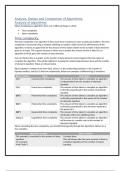Summary
Summary Algorithms
- Institution
- OCR
The algorithms section of the course can be considered the hardest, in this document there are explanations, summaries and examples of the different algorithms and will cover: Analyzing Algorithms Time Complexity Logarithms Space Complexity Searching Algorithms Sorting Algorithms Path-Findin...
[Show more]



